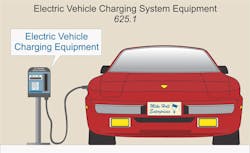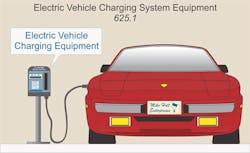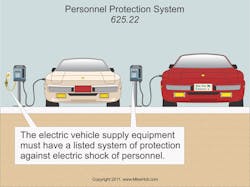Over the past few years, there’s been a lot of hype about electric vehicles (EVs). This attention has typically centered around the idea that they are a “green alternative,” but because most of our electricity is generated by burning coal, that’s not actually true. While it’s unlikely EVs will replace gasoline-powered cars any time soon, they do have their place. They’re also not technically all that new. In fact, many early models of the automobile were electric, and EVs have been in use ever since.
If you’ve worked in a factory or warehouse, you’ve probably seen an EV. A big advantage is they don’t have combustion fumes. Of course, there’s no free lunch. Electric lift trucks have their own issues. Someone repeatedly hauling heavy loads up ramps usually prefers to be driving an LP gas-powered truck rather than an electric one.
Out on the golf course, where loads are light — and you really don’t want the risk of oil leaks — electric golf carts are the preferred option. Inside airports and other areas where emission reduction is paramount, EVs are again a popular option.
These small, slow-moving off-road vehicles have charging requirements that small charging systems can easily meet. That is not the case with vehicles designed to carry passengers on roads at highway speeds. Such vehicles, especially an electric car or bus, weigh considerably more than a golf cart — so moving one takes a correspondingly larger motor. Moving it faster takes even more horsepower. This is why many designs use multiple drive motors.
While the electricity to power EVs comes over the power lines from generating stations, the fact that EVs have to be mobile means they must store that electricity to take it with them. The storage device of choice is the battery (there are other options, such as flywheel storage). At one time, you could bet it would be a lead-acid battery. Today, you’d want to place your bet on lithium batteries.
Sizing the battery for a given EV is a complex task because of all the demands the EV must satisfy. For example, to replace an internal combustion engine car, an EV must be able to travel at highway speeds over distances roughly comparable to those traveled by their internal combustion engine counterparts.
A car has loads you typically don’t find on a golf cart, such as air conditioning, electric windows, stereo systems, windshield wipers, security systems, and window defrosters. We also expect our car to start in the summer heat and cold of winter. For all these reasons, the battery system for an electrically powered passenger vehicle is considerably larger than that for a golf cart or other typical off-road electric vehicle. Consequently, the charging system must be far more robust than — and able to deliver far more power than — the charger for a golf cart.
This is why the electrically powered passenger vehicle needs a dedicated charging circuit. Making sure the charging circuit is safe is what Art. 625 is about. This Article provides the requirements for the electrical equipment needed to charge automotive-type electric and hybrid vehicles, including cars, bikes, and buses. It also applies to neighborhood electric vehicles (NEVs), which are basically road-certified golf carts. Article 625 does not apply to off-road, self-propelled vehicles, such as industrial trucks, hoist/lift trucks, golf carts, airline ground support equipment, tractors, or boats.
Any time you’re installing equipment and devices related to electric vehicle charging, Art. 625 applies (Fig. 1). It consists of five parts:
• Part I — General. This includes scope, definitions, voltages, and listing/labeling requirements.
• Part II — Wiring methods. The focus is on the charging coupler requirements the manufacturer must meet. You don’t need to understand the details of this part. You meet its requirements by using the coupler provided by the manufacturer.
• Part III — Equipment construction. Most of this applies to the manufacturer also, but it does have a few requirements you need to know.
• Part IV — Control and protection. This provides the requirements for overcurrent protection and the disconnecting means. It’s short and pretty straightforward.
• Part V — Supply equipment locations. The requirements for indoor sites differ from those of outdoor sites. As you might have guessed, ventilation is the difference.
Equipment construction
First, make sure that electrical materials, devices, fittings, and associated equipment are listed or labeled [625.5]. Also make sure the electric vehicle supply equipment has a listed system of protection against electric shock of personnel [625.22], as shown in Fig. 2.
Electric vehicle supply equipment must be marked by the manufacturer “for use with electric vehicles” [625.15]. If you don’t see those markings, something is wrong. Don’t assume that somehow the markings just inadvertently got skipped. You’ll have to track down this problem and correct it.
If you’re installing from a kit, don’t swap out parts. This is especially critical for any fasteners. Use the fasteners that come with the kit, and tighten them to the torque specifications provided in the instructions. Pay attention and “walk it through” before assembling, because once you tighten the connection, you really can’t do it over without getting new fasteners. Why is that? Because threaded fasteners have only half their design clamping power if re-used.
Electric vehicle supply equipment rated other than 15A or 20A, 125V must be permanently connected and fastened in place, unless it’s part of a system identified and listed as suitable for the purpose and meeting requirements of 625.18, 625.19, and 625.29 [625.13 and NFPA 70 TIA 11-2 for 625.13]. Connecting and fastening with fasteners you’ve already used isn’t actually permanent, because the connection can’t possibly stay tight. Therefore, re-using fasteners violates this Code requirement.
Control and protection
The first step in sizing conductors and overcurrent protective devices (OCPDs) is to characterize the load. One part of that step is to determine which loads are continuous and which are noncontinuous. If a load can be expected to run 3 hr or more, you must consider it continuous [100]. It’s expected that an EV will take more than 3 hr to charge, so you must consider any electric vehicle charging load to be continuous [625.14].
Because these loads are continuous, it follows that overcurrent protection for supplying electric vehicle supply equipment must have a rating of not less than 125% of the maximum load of the electric vehicle supply equipment [625.21]. For that same reason, the conductors must also be sized no less than 125% of the continuous loads based on the terminal temperature rating ampacities, as listed in Table 310.15(B)(16), before any ampacity adjustment [110.14(C)(1) and 210.19(A)(1)].
Electric vehicle supply equipment rated more than 60A or more than 150V to ground must have a disconnecting means that’s capable of being locked in the open position. You must install this at a readily accessible location. The provision for locking or adding a lock to the disconnecting means must be installed on (or at) the switch or circuit breaker. This has to remain in place with or without the lock installed [625.23].
Location, location, location
If you’re installing the system indoors, locate it so as to permit direct connection to the electric vehicle [625.29(A)], as shown in Fig. 3. You’ll need to consider the total distance (horizontally and vertically) to the charging connection on the vehicle. The charging cable is only so long, and you need to allow for some slack. So what might, at first glance, appear to be an ideal location may turn out to be unacceptable.
Locate the coupling means at least 18 in. above the floor level but not more than 4 ft above the floor level. Again, keep in mind the length of that charging cable.
Many garages have a faucet to facilitate cleaning. Article 625 does not specify, but don’t locate the system anywhere near these. It might even be necessary to move the plumbing, if nothing else, to avoid having the user stand in a puddle.
If the electric vehicle supply equipment is listed or labeled as suitable for charging EVs indoors without ventilation, then you don’t need to install mechanical ventilation. In all other cases, mechanical ventilation is required. Any such ventilation must include supply and exhaust equipment permanently installed, and located to intake and vent directly to the outdoors [625.29(D)].
If you’re installing the system outdoors, the same requirements apply, except you don’t need to worry about ventilation [625.30].
Planning the job
Before installing an electric vehicle charging system, scope out the location. Where would the vehicle(s) be parked, and how easy would it be for people to use the charging equipment? Is there a water source nearby, and how do you protect against it?
Most of Article 625’s requirements boil down to following the manufacturer’s instructions and using only the listed and labeled components provided with the equipment. So read the instructions, and inventory those components before starting the work. Then do a “walk through” of the installation. Make sure you have the correct torque wrenches and other equipment needed to complete each step.
Once you’re sure you have all the correct components, understand how to put them together, know which specialized tools you’ll need, and know where you’re going to install them, you’re ready to size the branch circuit conductors and protective device. You would do this the same way you’d do it for any other load per Art. 210 and Art. 220. Just note that you’re sizing at 125% because this is a continuous load [625.14 and 625.21].
About the Author

Mike Holt
Mike Holt is the owner of Mike Holt Enterprises (www.MikeHolt.com), one of the largest electrical publishers in the United States. He earned a master's degree in the Business Administration Program (MBA) from the University of Miami. He earned his reputation as a National Electrical Code (NEC) expert by working his way up through the electrical trade. Formally a construction editor for two different trade publications, Mike started his career as an apprentice electrician and eventually became a master electrician, an electrical inspector, a contractor, and an educator. Mike has taught more than 1,000 classes on 30 different electrical-related subjects — ranging from alarm installations to exam preparation and voltage drop calculations. He continues to produce seminars, videos, books, and online training for the trade as well as contribute monthly Code content to EC&M magazine.



